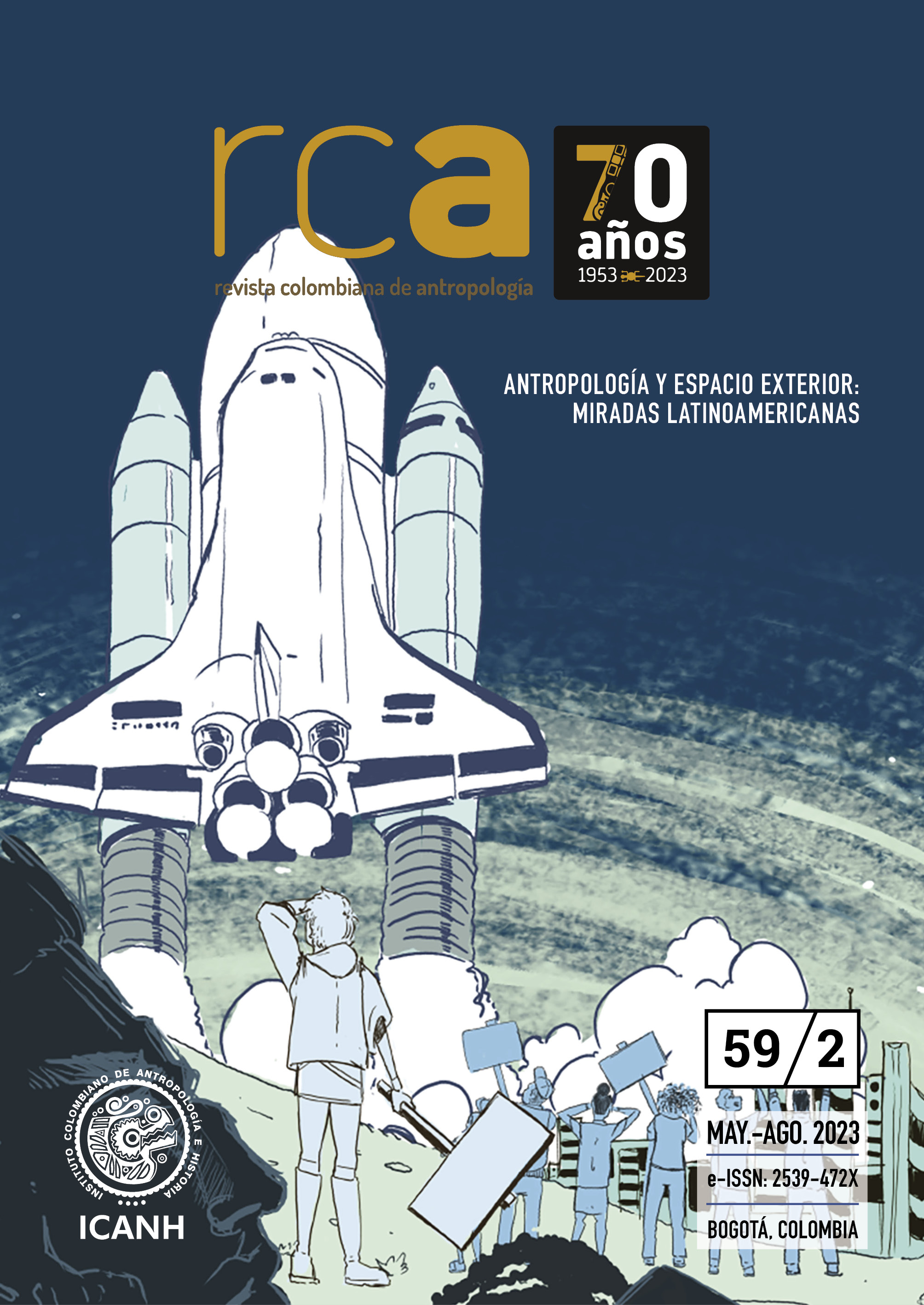México en órbita: sueños satelitales desde el sur
DOI:
https://doi.org/10.22380/2539472X.2437Palabras clave:
Satélites; Infraestructura; México; Tecnología; Espacio ExteriorResumen
Los satélites, aquellos cuerpos que orbitan de manera natural o artificial alrededor de otros cuerpos, ocupan un lugar privilegiado en el imaginario y las prácticas de la llamada “comunidad espacial” en México. En este texto, a partir de un conjunto de fuentes etnográficas y documentales, reflexionaré sobre estos objetos desde dos perspectivas: en la primera, los satélites: transforman el espacio y el lugar extendiendo el territorio hacia arriba y atravesando fronteras. En la segunda, devienen elementos fundamentales de ensamblajes infraestructurales o artísticos que conectan y coconstruyen sujetos y objetos, en algunos casos apelando a una especie de “sublime satelital” que busca reencantar la tecnología, el cosmos y la Tierra misma.
Descargas
Referencias bibliográficas
Bimm, Jordan. 2014. “Rethinking the Overview Effect”. Quest. The History of Spaceflight Quarterly 21 (1): 39-47. www.spacehistory101.com
Borrego, Jorge y Bella Mody. 1989. “The Morelos Satellite System in Mexico: A Contextual Analysis”. Telecommunications Policy 13 (3): 265-276. https://doi.org/10.1016/0308-5961(89)90009-8
Bureaud, Annick. 2021. “It’s a Beautiful Name for a Satellite: Paradoxical Art Objects Somewhere between Politics and Poetics”. Leonardo 54 (1): 79-91. https://doi.org/10.1162/leon_a_01987
Collis, Christy. 2 012. “ The Geostationary Orbit: A Critical Legal Geography of Space’s Most Valuable Real Estate”. En Down to Earth: Satellite Technologies, Industries, and Cultures, editado por Lisa Parks y James Schwoch, 61-81. Nuevo Brunswick: Rutgers University Press.
DeLoughrey, Elizabeth. 2014. “Satellite Planetarity and the Ends of the Earth”. Public Culture 26 (2/73): 257-280. https://doi.org/10.1215/08992363-2392057
Díaz Infante, Juan José, Fernando Castro, Ed Finn, Omar Gasca y Antonio Lafuente. 2017. Ulises I, una misión de arte al espacio por el Colectivo Espacial Mexicano. Puebla: El Errante Editor.
Dolman, Everett C. 2002. Astropolitik: Classical Geopolitics in the Space Age. Londres: Frank Cass Publishers.
Garciandia, Laura. 2017. “Dónde comienza el ser humano interplanetario: la misión Sputnik”. En Ulises I, una misión de arte al espacio por el Colectivo Espacial Mexicano, editado por Juan José Díaz Infante, Fernando Castro, Ed Finn, Omar Gasca y Antonio Lafuente, 31. Puebla: El Errante Editor.
Gärdebo, Johan, Agata Marzecova y Scott Gabriel Knowles. 2017. “The Orbital Technosphere: The Provision of Meaning and Matter by Satellites”. The Anthropocene Review 4 (1): 44-52. https://doi.org/10.1177/2053019617696106
González de Bustamante, Celeste. 2015. “Muy buenas noches”. México, la televisión y la Guerra Fría. México D. F.: Fondo de Cultura Económica.
Graham, Stephen. 2018. Vertical: The City from Satellites to Bunkers. Londres: Verso.
Heidegger, Martin. 2 009. “‘Only a God Can Save Us’: The Spiegel Interview (1966)”. En Heidegger: The Man and the Thinker, editado por Thomas Sheehan, 45-67. Londres y Nueva York: Routledge.
Henry, Holly J. y Amanda G. Taylor. 2009. “Re-Thinking Apollo: Envisioning Environmentalism in Space”. The Sociological Review 57 (1): 190-203. https://doi.org/10.1111/j.1467-954X.2009.01825.x
Ingold, Tim. 2000. “Globes and Spheres: The Topology of Environmentalism.” En The Perception of the Environment: Essays on Livelihood, Dwelling and Skill, 209-218. Nueva York y Londres: Routledge.
Litfin, Karen T. 1 999. “ The Status of the Statistical State: Satellites and the Diffusion of Epistemic Sovereignty”. Global Society 13 (1): 95-116. https://doi.org/10.1080/13600829908443180
Mack, Pamela Etter. 1990. Viewing the Earth: The Social Construction of the Landsat Satellite System. Boston: MIT Press.
Montaño Barbosa, Alejandro. 2015. “La trayectoria de México en la exploración espacial”. Cienciamx Noticias, 16 de diciembre. http://www.cienciamx.com/index.php/ciencia/universo/4714-historia-de-la-astronautica-en-mexico-del-sputnik-i-a-la-agencia-espacial-mexicana
Pang, Alex Soojung-Kim y Bob Twiggs. 2011. “Citizen Satellites”. Scientific American 304 (2): 48-53. http://www.jstor.org/stable/26002393
Parks, Lisa y James Schwoch. 2012. Introduction a Down to Earth: Satellite Technologies, Industries, and Cultures, editado por Lisa Parks y James Schwoch, 1-18. Nuevo Brunswick: Rutgers University Press.
Parks, Lisa. 2012. “Satellites, Oil and Footprints: Eutelsat, Kazsat, and Post-Communist Territories in Central Asia”. En Down to Earth: Satellite Technologies, Industries, and Cultures, editado por Lisa Parks y James Schwoch, 112-142. Nuevo Brunswick: Rutgers University Press.
Rivera Parga, José Ramón. 2017. “La exploración espacial: una oportunidad para incrementar el poder nacional del estado mexicano”. Revista del Centro de Estudios Superiores Navales 38 (4): 33-62. http://www.semar.gob.mx/redes/Articulo_Rivera_Parga.pdf
Rothe, Delf. 2017. “Seeing Like a Satellite: Remote Sensing and the Ontological Politics of Environmental Security”. Security Dialogue 48 (4): 334-353. https://doi.org/10.1177/0967010617709399
Sagan, Carl. 2013. Un punto azul pálido. México D.F.: Planeta.
Unesco. 2016. The Right to Dark Skies / El Derecho a los cielos oscuros. México D. F. y París: Unesco.
White, Frank. 1998. The Overview Effect: Space Exploration and Human Evolution. Reston, VA: AIAA.
Publicado
Cómo citar
Número
Sección
Licencia

Esta obra está bajo una licencia internacional Creative Commons Atribución-NoComercial-SinDerivadas 4.0.




















